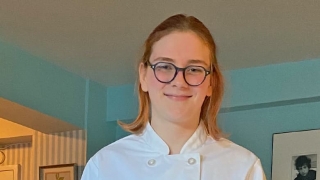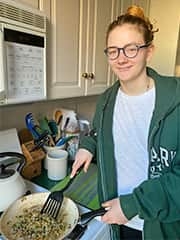Gastroparesis: Catherine’s Story
Published on
Published on
A mysterious stomach condition plagued Catherine for years, causing her pain, nausea, and affecting her ability to enjoy food. For the aspiring young chef, it was a recipe for frustration.
But thanks to clinicians and expert diagnosis at Children’s Hospital of Philadelphia (CHOP), the first-year culinary arts student is not only creating mouth-watering recipes for others – she’s finally able to enjoy them herself.
 For as long as she can remember, Catherine has had a “delicate” stomach. Growing up, she experienced frequent bouts of nausea, vomiting and constipation. She tried everything she could think of to improve her symptoms -- eliminating potential trigger foods like dairy and gluten, exercising more, and even seeing a therapist. But nothing worked.
For as long as she can remember, Catherine has had a “delicate” stomach. Growing up, she experienced frequent bouts of nausea, vomiting and constipation. She tried everything she could think of to improve her symptoms -- eliminating potential trigger foods like dairy and gluten, exercising more, and even seeing a therapist. But nothing worked.
“It was getting bad in my senior year,” Catherine says. “Toward the end of the year, I was definitely struggling to get through the day.”
Looking back, Catherine doesn’t remember a time when she didn’t experience at least some gastrointestinal (GI) discomfort. Catherine’s mom, Sarah, knew about her daughter’s GI issues, but because Catherine didn’t often complain, she assumed her daughter would outgrow the issue. Instead, the problem got worse.
When Catherine went away to college in Ohio, things went smoothly at first. She still had minor GI discomfort, but it was manageable. In her second semester, Catherine’s symptoms grew progressively in both intensity and frequency. It got so bad that twice she went to the local hospital seeking relief.
Then COVID-19 hit the United States and forced Catherine to return home to New York City for remote learning. At the time, she was barely functioning, living with constant cramps and sharp pain. “I felt pretty bad all the time,” Catherine says.
For months, she struggled to eat, and at times, couldn’t even hold down water. Instead, she experienced nausea constantly and vomited frequently. In two months, she lost nearly 50 pounds.
After witnessing Catherine’s sharp decline, her mother insisted they see a specialist. The duo visited multiple doctors in New York and Catherine underwent a series of tests, including a colonoscopy, endoscopy, and a gastric emptying study. But doctors said they could not find anything physically wrong with Catherine. Instead, they diagnosed her with generalized anxiety and referred her to a therapist.
Frustrated with the lack of answers, Catherine began her own research online for possible causes and treatment for her symptoms. That’s when she discovered the Suzi and Scott Lustgarten Center for GI Motility at CHOP. Catherine asked her mother to make an appointment.
Sarah says:
“The best decision we ever made was to go to CHOP. Catherine was admitted to CHOP and immediately had a whole team focusing on her stomach issues. ”
At CHOP, Catherine and Sarah met with Prasanna K. Kapavarapu, MD, an attending gastroenterologist with the Suzi and Scott Lustgarten Center for GI Motility, which is part of the Division of Gastroenterology, Hepatology and Nutrition.
Dr. Kapavarapu reviewed Catherine’s medical history, previous test results, and conferred with doctors in New York to compare previous test results.
Then, Dr. Kapavarapu ordered a second gastric emptying study, considered the “gold standard” for diagnosing gastroparesis. During the study, Catherine ate a small amount of a radio-labeled test meal of two scrambled eggs and bread. Clinicians use this meal to test how quickly the patient passes food through their digestive tract. The percentage of gastric emptying is measured at 60, 120, 180 and 240 minutes after the meal.
The test confirmed what Dr. Kapavarapu suspected: Catherine had gastroparesis, an uncommon condition that causes bloating, abdominal pain, nausea, indigestion, vomiting, weight loss and more. Because the symptoms of gastroparesis are often transient and may overlap with other more common chronic GI motility disorders, gastroparesis is often difficult to diagnose.
“No doctor before raised any major flag,” Sarah says. “Nobody pinpointed what was wrong with Catherine until we found Dr. Kapa – and then it was just a light bulb moment. He was the first one who said, ‘Let’s connect the dots’ [of her assorted symptoms] and that’s when things started to turn around for Catherine.”
Knowing Catherine’s diagnosis helped doctors guide her treatment. She was given medication to stimulate her stomach muscles to empty her stomach sooner. Then, doctors inserted a nasogastric (NG) tube to allow Catherine to be tube-fed essential nutrients. When the NG tube failed to help Catherine gain weight and get needed nutrients, doctors switched to feeding her with a nasojejunal (NJ) tube that bypasses the stomach and delivers nutrients directly to the small intestine.
After about six weeks using the NJ tube, Catherine finally began to gain weight and began a slow transition back to eating by mouth.
By the end of 2020, Catherine had weaned from the feeding tube and was successfully eating on her own. With the help of medication, she no longer experiences pain or nausea after eating. Today, Catherine is successfully managing her disease with diet, exercise and avoiding her stress triggers.
 “I feel 100% now,” Catherine says. “I credit CHOP for getting to the bottom of my condition.”
“I feel 100% now,” Catherine says. “I credit CHOP for getting to the bottom of my condition.”
CHOP will support Catherine as she begins her search for a new adult care provider closer to home who can help her manage her condition into adulthood.
Looking ahead, the young woman whose passion for cooking began as toddler mixing spices and hot sauce in her family kitchen, envisions working in a restaurant cooking French cuisine.
Catherine realized her true passion for cooking while taking a nutrition class in Ohio. She’s now a student at the Culinary Institute of America in New York City.
“I’ve always loved food,” says Catherine. “Now, I can finally enjoy what I am cooking.”